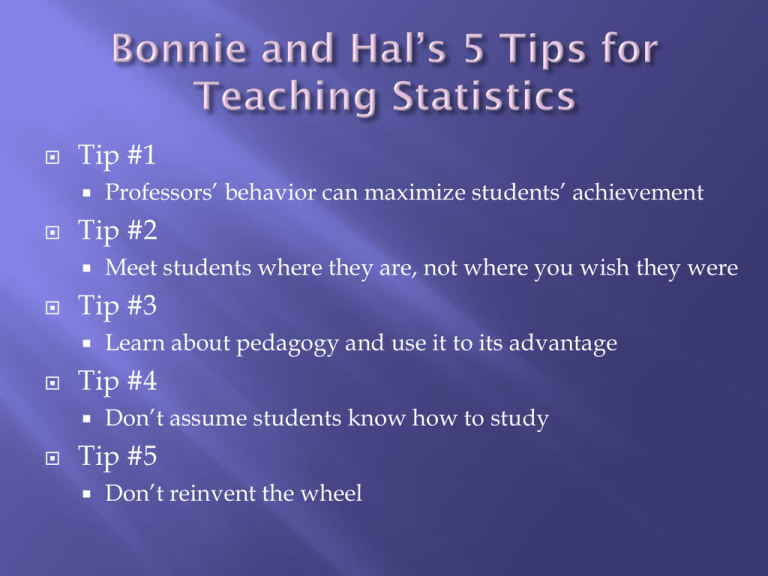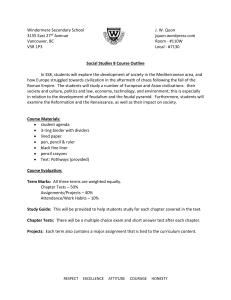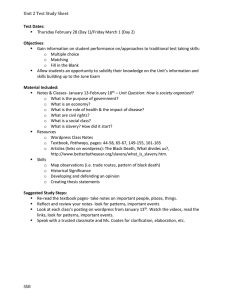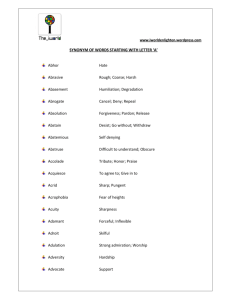Green and Kiess Teaching Statistics Feb 10 2011
advertisement

Tip #1 Tip #2 Learn about pedagogy and use it to its advantage Tip #4 Meet students where they are, not where you wish they were Tip #3 Professors’ behavior can maximize students’ achievement Don’t assume students know how to study Tip #5 Don’t reinvent the wheel Be a role model Demonstrate behaviors you wish to see in students Watch general tenor of class Don’t be a rude, arrogant, condescending jerk Do be yourself (at least the nice version of yourself) http://statisticalsage.wordpress.com/2010/09/19/want-toengage-students-dont-be-an-idiot/ Be prepared for class each day Practice calculations before coming to class If you say you are going to do something … do it Grade papers and return them promptly Formulate an explicit syllabus Assignments and requirements for each class How grades will be determined A bit about your expectations http://statisticalsage.wordpress.com/2010/08/16/7 5/ Structure syllabus to assure appropriate pacing Plan on spending more time on critical information Build a foundation at the beginning of the semester Statistics in the context of research Variability, chance difference, uses of statistics Calculating the Sum of Squares 1 day conceptually 1 day calculations Assignments and Exercises for Students 4.4 Extra few days of homework Assignments and Exercises for Students 5.2 http://statisticalsage.wordpress.com/2010/10/05/eng aging-learners-by-focusing-on-three-learning-styles/ Sampling Distribution of the Mean 1 day M&M activity 1 day conceptually Standard Error Foreshadow this concept by talking about individual differences in every class Every time you introduce a new research topic, have students identify potential individual differences that can lead to sampling error Tie in with sampling distribution of the mean activities/ discussion Point out where the standard error is being calculated in various statistics Discuss beliefs about attitudes and their relation to academic success Encourage students to adopt a growth mindset Have students complete Exercises 1.1 to 1.4 of Assignments and Exercises for Students. Discuss their responses in class or on a discussion board Have students complete a mindset survey http://mindsetonline.com/testyourmindset/step1.php http://mindsetonline.com/whatisit/about/index.html Engage students from the first day You are the best tool you have http://chronicle.com/blogPost/How-to-Avoid-Being-a-Jerk-in/26427/ Engage the various modalities, visual, tactile, and kinesthetic http://statisticalsage.wordpress.com/2010/10/05/engaging-learners-by-focusing-on-three-learning-styles/ Get students interacting and talking On the first day Be three standard deviations from the mean with a discussion on variability http://statisticalsage.wordpress.com/2011/01/29/first-day-of-class-starting-off-right/ Every day Pedagogical practice (discussed later) Anticipatory Set (opening activities) Every Pupil Response Modeling of calculations Using data gathered from students http://statisticalsage.wordpress.com/2010/09/12/getting-them-to-talk/ There are additional examples throughout this presentation They would rather be in almost any other course Engage students from the first day It is likely they have no idea of why this course should be relevant to their plans Ask students to generate questions they would like to answer Point out that statistics can be the tool to help answer these questions Use their questions as examples while defining those first few terms variability, statistics, variable, and data Many students come to college woefully illprepared in mathematics Order of operation for calculations The difference between squaring a number and finding the square root How to use the calculator for finding a square root or to square a value Lining up the decimals before adding subtracting How to convert a fraction into a decimal Learn how to control your “You have got to be kidding me” micro (macro)-expressions on your face Assign daily homework that meets the needs of your students (discussed later) Use modeling to your advantage During steps of the calculation, include reminders of elementary math You can have fun with it by acting like you are “Calling a Game” “Describing a Fashion Show” “OK, so here we have two negative numbers that we need to multiply. A negative times a negative is a positive … ” “Now it’s time to square three, so that’s three times three, and we end with nine” “What order should I calculate this in … oh, yes, Please Excuse My Dear Aunt Sally. We start with ‘please’ the P in ‘please’ stands for calculating what is in the parentheses first” It is not uncommon for more than ½ of a class to report high levels of math anxiety As discussed earlier, having students adopt the optimal mindset will Decrease their anxiety Increase behavior associated with success Due to a lack of prior academic success, particularly in math, students often have low self-efficacy beliefs Students’ with low self efficacy and/or entity mindset have behaviors that Keep them from being successful Can be interpreted that they don’t care Solution Structure the class, homework, and non-graded quizzes so students can experience success Quickly identify any potential areas of weakness Help students adopt a growth mindset Use other techniques discussed (e.g., Every Pupil Response or “Calling the Game”) English may be a second language for some students Students may have weak reading skills Solution Provide students with outlines of the reading material Provide students with a list of vocabulary and symbols All of the above recommendations, especially providing relevant, real life examples and having students generate ideas themselves Concrete/real life/ relevant examples Teaching statistics as theory can be too abstract Much of statistics developed in an applied context Fisher developed many statistical techniques in his studies of the effect of soil fertility on plant growth Students enjoy hearing about research being conducted by people you know Collect data from students Students enjoy “current” topics Your source for the latest psychological research. Research found that in just and fair organizations, local employees were more likely to offer aid to their foreign coworkers Being treated differently because you’re a foreigner doesn’t have to be a bad thing. Research published in Psychological Science found that in just and fair organizations, local employees were more likely to offer aid to their foreign coworkers. Psychological scientists Geoffrey Leonardelli and Soo Min Toh, Univeristy of Toronto conducted two field studies on various local employees who have worked with an immigrant from another country. Locals were more likely to aid their foreign coworkers by sharing information and knowledge about the local area when there was clear categorization of local or foreigner and when they felt the organization was fair and bias-free. “Group-based differences often create an ‘us versus them’ mentality,” says Toh. “However, we found that when employees felt that they were treated fairly by their employers, group-based differences were more likely to manifest as an ‘us and them’ mentality.” Toh and Leonardelli’s findings suggest that immigrants may benefit more from openly sharing their foreign origin with coworkers rather than trying to blend in as a local. Leonardelli GJ, & Toh SM (2011). Perceiving expatriate coworkers as foreigners encourages aid: social categorization and procedural justice together improve intergroup cooperation and dual identity. Psychological science, 22 (1), 110-7 PMID: 21148458 Don't be afraid to introduce some basic principles of research Understanding statistics in the context of research Increases understanding Increases sense of relevancy Much of applied statistical thinking has been driven by attempting to improve decision making from data Business decisions Games of chance. Where would casinos be without a grasp of probability? Predicting behavior like suicide or marital happiness Building upon research by cognitive developmental psychologists, this pedagogical practice encourages the instructor to Recognize when students are in the Zone of Proximal Development Students cannot complete a task on their own, but can with assistance Constrain the complexity of the situation so students can master the task After mastery, the constraint is removed, yet the student is still successful at the task This approach results in a much greater speed of learning Kiess and Green (2010) applies this technique Before having students find the variance, have them practice finding the sum of squares (e.g., Assignment and Exercise 4.4 and 5.2) Set A X 22 23 25 24 21 (X – M) (X – M)2 Once they master finding the SS, finding the variance (sd, z-test, t-test, or r ) becomes much easier Sometimes it may seem like students should be able to put multiple steps together Adding that last step can be the straw that breaks the poor camel By having students master the component pieces before putting them together, greater and faster success will be realized Modeling Discussed Previously Showing students how to complete a problem is not as helpful as truly modeling it for them, like “Calling a Game” or “Describing a Fashion Show” Have students work along with you, completing the parts they already know how to do Every Pupil Response Every Pupil Response Every Pupil Response is a pedagogical technique that expects all students in the class to simultaneously respond Getting students talking or engaging increases their intellectual engagement There are different ways of getting all students to respond This link has a list of activities for K – 6 students, but many of them will work for college students. http://daretodifferentiate.wikispaces.com/file/view /Pre-assessment+Techniques+Chart.pdf Have everyone respond in unison What is this symbol? “little sigma” What does it represent? “population standard deviation” Other examples: Thumbs up, thumbs down for true and false questions Students can shade in area in a normal distribution Using your hand to demonstrate the answer (Likert Scale) Using your hand, show me what the sum of the deviations should be? “fist” or “O.K.” sign is shown to illustrate zero With a thumbs up or down, who found the answer? http://statisticalsage.wordpress.com/2010/09/ 12/getting-them-to-talk/ Visual, Tactile, & Kinesthetic Activities For decades, K-12 educators have been telling children they are either auditory, visual, tactile, or kinesthetic learners The research is questionable regarding students being better suited for one style of learning over another http://chronicle.com/article/Matching-TeachingStyle-to/49497/ All people benefit from visual illustrations or hand-movements from the professor Illustrations on the chalk board Using sign language with initial letters (works well with EPR) Mathematica http://statisticalsage.wordpress.com/2011/01/08/bef ore-the-semester-starts-im-playing-with-pictures/ Hands-on activities (e.g., poker chips) You will keep students attention if they have to move Have students draw concepts Identifying and shading in regions associated with zscore and the normal distribution The location of a t-test or F-test on the appropriate distribution An opening class exercise presented to students prior to the start of direct instruction Enables students to anticipate what will be covered during class Increases effective encoding of newly taught information Increases integration of new material with previously learned material Can make use of the benefits of self testing Used to Motivate students Help students get mentally prepared to learn material Provides the context for the lesson Examples of Anticipatory Set Non-graded quizzes Asking students to discuss a topic Provide students with a question at the end of the prior class, and begin by discussing their answers at the start of class Minute Papers Give students a minute to write what they learned from the prior reading material, homework, or class Encourage students to make use of: Flash cards for terms and symbols Assignments and Exercises for Students http://www.pearsonhighered.com/educator/produ ct/Statistical-Concepts-for-the-BehavioralSciences/9780205626243.page Assignments in the textbook Provide students with answers Entire problem Intermediate steps Assign homework so students will be most likely to experience success Space studying 6 days a week, with 1 day off 1 hour per day Make assignments specific Problem numbers Terms Symbols Pages to read in the book Self testing Encourage students to treat homework like it’s an exam … closed note, closed book (though they should have the statistical formula in front of them) Early in the semester, use research on study skills as examples for the concepts you are teaching Cassaday, H. J., Bloomfield, R. E., & Hayward, N. (2002). Relaxed conditions can provide memory cues in both undergraduate and primary school children. British Journal of Educational Psychology, 72, 531-547. Gurung, G. A. R. (2005). How do students really study (and does it matter)? Teaching of Psychology, 32, 239-241. Roediger, H. L., & Karpicke, J. D. (2006). The power of self testing memory: Basic research and implication for educational practices. Perspectives in Psychological Science, 1, 181-210. It may be worth it to spend 20 minutes talking about optimized study skills to your students http://statisticalsage.wordpress.com/2011/02/05/hel ping-students-with-study-skills/ There plenty of available resources Journal of Statistics Education, an ASA journal Teaching of Psychology Journal Textbook supplements Books geared toward teaching statistics Ware, M. E., & Brewer, C. L. (Eds.). (1999). Handbook for teaching statistics and research methods (2nd ed.). Mahwah, NJ: Erlbaum. Dunn, D. S., Smith, R. A., & Beins, B. C. (2007). Best practices in teaching statistics and research methods in the behavioral sciences. Mahwah, NJ: Erlbaum. Supplemental Materials for Kiess and Green (2010) Extensive instructors’ manual PowerPoint presentations Assignments and Exercises for Students Test Bank http://www.pearsonhighered.com/educator/product/Statisti cal-Concepts-for-the-Behavioral-Sciences/9780205626243.page Statistical Sage Blog We review, synthesize, and summarize what we and others are doing and saying about the teaching of statistics http://statisticalsage.wordpress.com/ Don’t forget to tell us what is working for you and what isn’t! Thank you! Questions? bgreen@po-box.esu.edu or hkiess@verizon.net statisticalsage/wordpress.com





